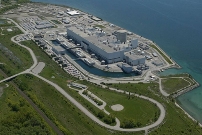Refurbishment for Darlington, but not Pickering B
17 February 2010
A two-part investment strategy announced by Ontario Power Generation (OPG) will see the refurbishment of the Darlington nuclear power station, while the Pickering B plant will be operated for up to ten more years and then shut down.
 |
| The four reactors at Darlington will get a new lease of life (Image: OPG) |
OPG said that, following "very positive outcomes of initial studies on the plant's condition and continued strong operating performance," it will proceed with a detailed planning phase for the refurbishment of the Darlington plant. The company said that the next phase in the process will include an Environmental Assessment, an Integrated Safety Review and an Integrated Improvement Plan that will define the scope, cost and schedule of the refurbishment project. Refurbishing Candu units consists of such steps as replacing fuel channels and steam generators and upgrading ancillary systems to current standards. Refurbishment work is expected to begin in about 2016 and should extend the lives of the Darlington units by some 30 years.
Meanwhile, OPG announced that it will invest C$300 million ($287 million) to ensure the "continued safe and reliable performance" of its Pickering B plant for some ten years. "Following this," the company said, "OPG will begin the longer term decommissioning process as refurbishment for Pickering B station will not be pursued." Once the reactors have been shut down, they will be placed in safe storage.
"Extensive safety, environmental and equipment reliability studies conducted at the station concluded the Pickering plant can continue to operate safely and reliably to meet the province's energy needs through to 2020," OPG said. It has already indicated to the Canadian Nuclear Safety Commission (CNSC) that later in 2010 it will submit a Continued Operation Plan that takes Pickering B to its end of life.
Ontario's minister of energy and infrastructure, Brad Duguid, said: "As Ontario's generating company, OPG's nuclear and hydro fleets are the backbone of the provincial electricity system." He added, "I support this business investment strategy as it aligns with the government's vision for a clean energy future."
Pickering is one of the world's largest nuclear generating facilities consisting of the Pickering A and Pickering B plants. Pickering A has two operating Candu reactors and Pickering B has four operating Candu units. Together these plants have a total output of 3100 MWe.
Pickering A - the first four of the Pickering reactors - went into service in 1971 and continued to operate until 1997 when the plant was placed in voluntary lay-up as part of what was then Ontario Hydro's nuclear improvement program. In September 2003, following refurbishment, unit 4 was returned to commercial operation. Unit 1 was returned to service in November 2005 after also being refurbished. Units 2 and 3 remain in a safe shutdown state.
Pickering B - units 5, 6, 7 and 8 - was brought into service in 1983. They have a combined capacity of approximately 2100 MWe. OPG had considered refurbishing the units at Pickering B in order to extend their operating lives until 2050-2060.
The Darlington plant is OPG's newest Candu nuclear generating station. It is a four-unit plant with a total output of 3524 MWe. It provides about 20% of Ontario's electricity needs.
"In planning the Darlington refurbishment, OPG will build on the accomplishments and lessons learned during the Pickering A restart and the Pickering safe storage project," the company said.
The Darlington site has been selected by the government of Ontario as the location for the province's next nuclear generating facility. OPG submitted its environmental impact assessment of new reactors at Darlington to the CNSC in October 2009, although the government plans to build had by then been put on hold. A number of power reactors totalling up to 4800 MWe in generating capacity are proposed for the site, directly adjacent to the existing four-reactor Darlington plant.
Researched and written
by World Nuclear News